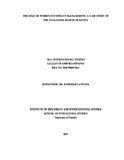| dc.description.abstract | Sexual assault and exploitation are frequently employed as tools of war; victimization
leads to isolation, alienation, prolonged emotional trauma, and unwanted pregnancies that
often result in abandoned children. As culturally-designated caregivers, women must
struggle to support their families and keep their households together while the traditional
bread-winners are caught up in the fighting and are unable to provide for their families.
This is not only exclusive to Pokomo and Kamba communities in Tana River only, but in
Rift Valley and upper Rift Valley areas such as Turkana where there are frequent
intercommunity wars; between Turkana and Pokot due to cattle rustling. Therefore this
study sought to investigate the role played by women in Mutitu Sub-county Divisions in
conflict management; to identify the strategies used by women in Mutitu Sub-county
divisions in managing conflicts; and to evaluate the effect of inclusion of women in
conflict management processes in Mutitu Sub-county divisions. Study relied on the
Feminist peace theory developed in 1794 by Mary Wollstonecraft. The study used ex
post factor research design. The study was carried out in Tana River County. The major
ethnic groups of the Tana River District are the Pokomo, many of whom are farmers
along the Tana River, and the Kamba, who are predominantly a cattle-herding nomadic
people. The study sampled women respondents from the Kamba and Pokomo
communities, and further included past studies and information collected by other
scholars on the conflict between the two communities. The recorded data was transcribed
before the critical analysis. The study analyzed the data using quantitative and qualitative
data analysis methods. Secondary data was analyzed using content analysis. The study
found out that women were actually involved in peace initiatives or conflict management
situations in the Tana River. The women were involved in the initiatives through
structured committee models, disarmament efforts and even through traditional means.
However in some cases, this inclusion was rather limited since the women and minority
members in the DPC expressed dissatisfaction with their lack of involvement, claiming
that male elders still had far more influence. From the study, it is evident that a wide
range of conflict management strategies were used by women in Tana River. This implies
that the government should try to explore a conflict management strategy that is effective
and not easily dominated by the male representatives. In terms of policy, the study
findings shed light on the importance of gender sensitivity and inclusion in managing
conflicts. Contextually, the study was limited to conflict in Tana River in Kenya, and that
these findings may not represent the situation in the whole country. Methodologically,
that this study relied on women alone to give feedback, and thus ignored other
stakeholders like youths and elders who might be actively involved in the management of
conflicts alongside the women, therefore creating a source of bias. | en_US |

